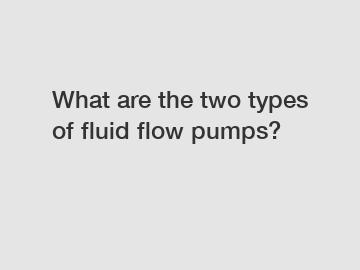What are the two types of fluid flow pumps?
Fluid flow pumps play an integral role in numerous industries, ranging from manufacturing to agriculture and from healthcare to energy production. They are essential devices used to transport liquids efficiently and effectively. In this article, we will explore the two primary types of fluid flow pumps: centrifugal pumps and positive displacement pumps. By delving into their mechanisms, applications, and advantages, we aim to provide you with a comprehensive understanding of these indispensable tools.
1. Centrifugal Pumps: Harnessing Centrifugal Force.
Centrifugal pumps are the most commonly used type due to their versatility and ability to handle a wide range of fluids. These pumps operate by converting rotational kinetic energy into hydrodynamic energy, utilizing centrifugal force. They consist of a rotating impeller that accelerates the liquid outward, causing a drop in pressure which draws more fluid into the pump.

a) Mechanism: Centrifugal pumps operate through the interaction of components like the impeller, volute, and shaft seal. The impeller rotates rapidly, imparting kinetic energy to the liquid which accelerates radially outward. The volute directs the flow while converting the kinetic energy into pressure energy, effectively generating the required fluid flow.
b) Applications: Centrifugal pumps find their application in various industries, including water supply, wastewater treatment, HVAC systems, chemical processing, and oil refining. Their ability to handle large volumes of fluids and adapt to various system requirements makes them a popular choice.
c) Advantages: Centrifugal pumps offer several benefits, such as compactness, high efficiency, and low maintenance requirements. Additionally, they provide a continuous flow of fluids, making them suitable for large-scale applications. Their ease of installation and diverse range of sizes make them highly versatile across industries.
2. Positive Displacement Pumps: Precise Volume Delivery.
Positive displacement pumps work by displacing a fixed volume of liquid, generating flow through successive filling and emptying of operational chambers. In contrast to centrifugal pumps, which rely on centrifugal force, positive displacement pumps mechanically trap and force fluid through the system, delivering accurate and precise volumes.
a) Mechanism: Positive displacement pumps include various mechanisms, such as reciprocating, rotary, and screw-driven actions, to trap and displace liquids. A common example is the reciprocating pump, which uses piston-like components to move the fluid in a reciprocating motion, creating a suction and discharge process.
b) Applications: Positive displacement pumps find extensive use in applications requiring precise control of fluid flow, such as metering systems, chemical dosing, pharmaceutical manufacturing, food processing, and hydraulic systems. These pumps are ideal when uniformity and consistent volume delivery are critical.
c) Advantages: The key advantage of positive displacement pumps is their ability to maintain a constant volume flow rate regardless of system pressure changes. This attribute allows for precise control over output, making them suitable for applications where dosage accuracy is crucial. Furthermore, these pumps can handle various types of fluids, including viscous and abrasive media.
Conclusion.
Fluid flow pumps are vital components in numerous industries, enabling the efficient movement of liquids from one point to another. Understanding the two primary types of fluid flow pumps, centrifugal pumps and positive displacement pumps, is essential for selecting the most appropriate option for specific applications.
Centrifugal pumps leverage centrifugal force to transport fluids, offering high flow rates and adaptability to various industries. On the other hand, positive displacement pumps excel at delivering precise and consistent volumes, making them ideal for applications requiring metering and dosage accuracy. Both types of pumps possess unique advantages and cater to specific requirements, ensuring the smooth operation of processes where fluid transport is critical.
By familiarizing ourselves with the mechanisms, applications, and benefits of these two types of fluid flow pumps, we can make informed decisions when it comes to implementing the most suitable solution for fluid transport needs.
For more gas filling machine, nitrogen gas pump, gass boosterinformation, please contact us. We will provide professional answers.

Comments